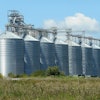As the economy continues to decline and financial experts say we're headed into a recession, American families struggle to put both food on the table and gas in the tank. 2008 saw a 36% increase in milk prices compared to 2007, and the national average price for a gallon of unleaded gas peaked at $4.11 in July. These circumstances have some people asking "Do I feed my kids, or my car?"
Although research released by the American Farm Bureau Federation says that the climb in food costs are due to the high price of crude oil, many people are quick to point a finger at the ethanol industry because of the misconception that most of America's corn is going into ethanol production, rather than food production.
Technology exists, however, that makes it possible for the same corn used to produce ethanol can also be used to make a variety of food-grade products. Through a process called fractionation, each portion of the kernel is separated and can be made into a variety of valuable products. ICM Inc. has made it its mission to help end the food vs. fuel debate by providing ethanol plants solutions and technology to produce food and fuel.
Fractionation makes it possible
Dave Vander Griend, president and CEO of ICM, Inc., could be described as a pioneer in trying to discover ways to settle the food vs. fuel debate. "My main message is there shouldn't be a food vs. fuel debate. We've known all along that we can create food while producing fuel; we just had to develop the technology that would present this opportunity to the ethanol producer," Vander Griend says.
The key to making Vander Griend's vision of producing food and fuel at the same time was fractionation. Fractionation is a mechanical separation of the kernel into three fractions: endosperm, bran and germ. The endosperm, which is about 83% of the kernel, is fermented to produce ethanol, while the other 17% of the kernel can be used to make animal feed, corn oil, syrup or a protein powder.
More than four years of research and development went into ICM's six-solution fractionation system. The step model includes 1) dry corn fractionation, 2) solid fuel combustion, 3) food-grade germ-oil extraction, 4) food-grade protein extraction from germ, 5) high-value single-cell protein feed from syrup and 6) ethanol from fiber.
Doug Rivers, director of research and development at ICM, Inc. suggests, adding the system on to existing facilities because of the lower capital investment compared to building a plant from the ground up. "The dry fractionation system can be put on any traditional dry corn mill. One of the advantages is it's a stepwise process and if you put the fractionation upfront, then you only have to make around a $40 million investment. And as you go on, you can decide to invest more; you don't have to put in all of the six steps at once," Rivers says.
The first two steps are necessary, however. The dry fractionation provides the fractions that each of the following steps requires to produce the food or feed co-product. The combustion provides the power for the boilers where the ethanol is brewed. The solid fuel combustor gives the ethanol producer the option of what type of fuel to use. A plant may burn wood chips, stover, corn cobs or even the syrup produced from the initial fractionation.
Besides adding the option to make value-added co-products, fractionation has another benefit. It reduces the level of non-fermentables that go into the fermentation vessel, maximizing a facility's ethanol production capacity. An existing 110 million gallon/year-plant can increase its capacity to 130 million gallon/year by adding a fractionation system.
Food grade solutions
After the parts of the kernel are fractioned off, the bran and germ are left over while the endosperm is fermented. The germ is high in oil and protein, which can be separated from each other providing a variety of food-grade options for consumers. The germ oil extraction technology requires further processing at this point and must be marketed to corn oil refinery centers.
The protein portion possesses a more versatile list of possibilities, and has the most potential to end up in human food. The protein can be made into a powder that is tasteless, colorless and, according to Rivers, a dream come true for lactose-intolerant milk lovers. "Soy milk has a yellowish brown tint, but we've figured out how to take the protein and make it into a completely white powder with absolutely no taste. And similar to milk and soy drinks, it can be flavored by adding chocolate, strawberry or butterscotch flavor," says Rivers.
While still in the development stage at ICM's pilot plant, LifeLine Foods in St. Joseph, MO, upon completion Rivers expects the powder to be marketed as a protein additive for snacks and other solid foods. He anticipates the product could be sold to the snack sector for up to $6/pound once its full potential is realized. ICM is in the process of defining the properties of the powder for its use in food formulations. "It could be used as an egg white substitute because of its foamy property. In the lab we're trying to find ways to get this into the food companies where they would test it to see if it could be worked into an existing formulation," Rivers says.
Rivers hopes that once these solutions become aware to the public, the negative attention toward the ethanol industry will die down. "When more people understand all the food possibilities ethanol production can create, it will change the focus from food vs. fuel to food and fuel. You're likely to see signs in the future that read ICM food and fuel facility,'" says Rivers.
New feed-grade solutions
Another co-product of ethanol is a high-protein feed product called dried distillers grains. DDG has already gained popularity with dairy and cattle producers over the past few years, but the swine and poultry sector has not been able to take advantage of the feed because of its high fiber content. However, ICM has developed a way to reduce the fiber content enough to make DDG advantageous for these markets.
ICM has also developed a protein feed additive from the syrup created in the fermentation process. A traditional mill could sell that corn syrup, but when employing the dry-fractionation technology, the protein in the syrup has already been extracted before reaching the fermentation step. ICM's method captures value despite the loss of protein. "We've created a single cell protein from this very low-grade syrup. It can be made into yeast and added into animal feeds to increase protein," Rivers says.
Creating food, feed and fuel in one process may be the answer to the food vs. fuel debate. Using fractionation to separate the endosperm, bran and germ opens up many marketing possibilities and may help the public understand that making ethanol doesn't only provide fuel, but also human food additives and substitutes and animal feed.
Biofuels in the News
VeraSun names Timm Hoffman as vice president
VeraSun Energy Corp. announced that Timm Hoffman has been named the company's vice president of information technology. In his new role, Hoffman will be responsible for strategic planning, development, and execution of information technology infrastructure and initiatives. Hoffman joins VeraSun following a 12-year career with Gateway.
Hoffman most recently served as Gateway's vice president, IT applications and infrastructure. Prior to Gateway, he held IT positions with the Nebraska Public Power District, Black Hills Power and Light, and John Morrell and Co.
Quad County Corn chooses FCO2 as fractionation technology provider
FCStone Carbon LLC (FCO2) announced that Quad County Corn Processors (QCCP) has engaged with FCO2's engineering and construction partner Agri Process Innovations (API) of Stuttgart, AR, to design and build the Quick Germ Quick Fiber Modified Wet Milling corn fractionation process at QCCP's ethanol plant near Galva, IA.
"We have been very impressed with how QCCP has evaluated the broad field of fractionation technology and are extremely pleased that upon completing their due diligence process they have chosen our package," comments Mike Kinley, chief operating officer, FCO2.
The patented fractionation technology was developed at the University of IL, Urbana-Champaign and exclusively licensed to Maize Processing Innovators, Inc. (MPI), based in Champaign, Illinois. It offers significant benefits to ethanol plants who wish to separate the corn kernel's component parts for further downstream processing.
The process utilizes a short soaking step and generates a more pristine germ and fiber fraction, minimizing the starch loss found with alternative dry fractionation techniques.
Biofuels plants recognized for energy efficiency
EPA has recognized POET Biorefining in Ashton, IA, and East KS Agri-Energy, LLC in Garnett, TN., for reducing energy consumption and greenhouse gas emissions. ENERGY STAR awards were given to these facilities at the 24th annual International Fuel Ethanol Workshop and Expo in Nashville, Tenn.
In April 2004, POET began full production at an ethanol plant in Ashton. Electricity is generated by a natural gas-fired turbine, which requires approximately 16 % less fuel than typical on-site thermal generation and purchased electricity. Based on this comparison, the system reduces carbon dioxide emissions by an estimated 18,900 tons/year, which is equivalent to removing the annual emissions from 3,100 cars or planting 3,900 acres of forest.
The East Kansas Agri-Energy dry mill ethanol plant in Garnett, KS., began production in 2005. The steam turbine system generates approximately one-third of the facility's electrical demands. It requires approximately 23% less fuel than typical on-site thermal generation and purchased electricity. Based on this comparison, the plant reduces carbon dioxide emissions by an estimated 14,500 tons/year, which is equivalent to removing the annual emissions from 2,400 cars or planting 3,000 acres of forest.
Iowans vote to increase checkoff by 50%
The Iowa Department of Agriculture and Land Stewardship announced that the state's corn growers overwhelmingly voted to increase the state's corn checkoff from a 1/2 to 3/4 cent/bushel. Preliminary results of the July 8 poll show 73% voted in favor of the increase and 27% voted against it.
In accordance with Iowa Code, the IDALS conducted the vote and has 30 days to officially certify the results.
The Iowa Corn Promotion Board invests checkoff dollars for research, education, promotion, and market development.


















